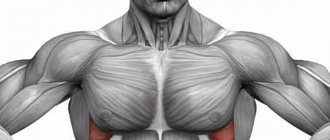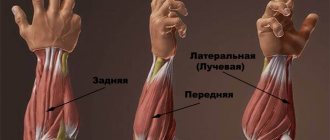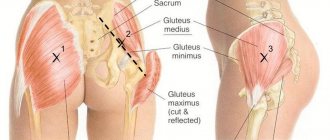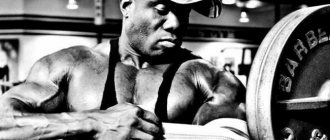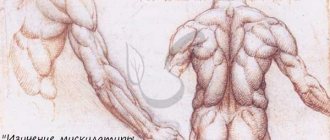Today I want to talk about how (possibly) Spartan warriors had such expressive abs and were invincible in battle.
No, now I’m not going to talk about how hard they trained and what discipline they had. I will tell you about ancient magic that will help turn your sides hanging down to your knees into a mountain of muscles , at the sight of which any conductress will allow you to ride like a hare.
What is the difference between fat and muscle?
Muscle and fat tissue have completely different structures and purposes. Fat deposits are an emergency source of energy for the body, so the presence of such tissue is inherent in human nature. Even if a person stops eating, he will not die immediately. The average man can live about 25 days without eating. This ability is provided by fat deposits. The main reason for their formation is the excess of calories entering the body over their expenditure and lack of physical activity.
Muscles are primarily made of protein. Thanks to the ability of fibers to contract under the influence of nerve impulses, a person has the ability to move and perform various types of manipulations. Human nature provides only two possible states:
- accumulation of fat deposits and mass;
- loss of fat and mass.
Trying to lose fat and gain muscle mass at the same time will not work.
In order to begin to build muscle mass, the body needs an increase in calories entering the body, which in turn starts the process of storing fat.
In this regard, it is impossible to quickly turn fat into muscle, but you can start a process that in the sports environment is called fat burning.
Why you can swim fat if you stop training
Gaining muscle mass involves a positive calorie balance—in other words, it causes people to eat more. In this case, part of the energy consumed is spent on physical activity during training, and part is spent on maintaining increased muscle mass.
When a person stops exercising but does not change his diet, the unspent energy accumulates in reserve in fat cells. At the same time, muscles left without load decrease in volume.
Our body is designed to conserve energy, and if muscle mass is not used, the body will not spend calories on its maintenance.
This process happens slowly - the first changes begin Exercise Break: How Long Does It Take to Lose Muscle Mass? 3–4 weeks after stopping training. However, if you do not resume activity, the body will gradually get rid of excess muscle baggage.
But even before the muscles decrease in volume, they can hide under a layer of accumulated fat, so that an athletic physique turns into a blurred figure with unaesthetic folds.
Basic Rules
Fat can be converted into muscle fiber only by organizing proper nutrition and providing the body with a sufficient level of stress in the gym or at home. The mistake of many beginners is that they want to get this result quickly. It is worth knowing that fat burning does not happen instantly and for this it is necessary to take comprehensive measures. Basic recommendations:
- Provide the body with proper nutrition in the form of low-carbohydrate, high-protein foods;
- exclude foods with fast carbohydrates from your diet, such as sweet flour products, cakes, candies and other sweets;
- go to the gym 3 times a week;
- give your muscles rest after training for at least 48 hours;
- during aerobic exercise in the gym, monitor your pulse, it should not be less than 120 beats;
- Take advantage of special sports nutrition and fat burners.
No strict diet without exercise in the gym or at home will help quickly transform fat into muscle, and the effect of the achieved result in the form of weight loss can, after some time, turn the process into a greater gain of unwanted body weight.
It is worth remembering that aerobic exercise in the form of running, swimming and cycling quickly burns fat. Strength exercises and training with a large number of repetitions in one approach are effective for gaining muscle mass.
Can these changes be prevented?
You can maintain a healthy weight by adjusting your diet to accommodate your new level of physical activity. In this case, the muscles will lose some volume, but excess fat will not accumulate. In addition, if you change the type of exercise, for example, instead of strength training, introduce aerobic training - running, triathlon, cardio sessions, you will not gain excess fat even without reducing the caloric content of your diet.
So there is no point in being afraid of strength training. If you monitor your diet and adjust it in time to suit your level of physical activity, weight training will only bring you benefits.
Fat burning: rules and recommendations
To start the fat burning process, it is necessary to create a deficiency of glucose in the body, which is synthesized from adipose tissue. At the first stage, two factors are of paramount importance:
- the diet should contain fewer calories than the human body uses during the day;
- workouts should include exercises to maximize energy expenditure.
A low-calorie diet will help to quickly reduce the level of body fat, but too strict diets should be excluded. Otherwise, the body will begin to break down muscle fibers.
It is worth remembering that the training program in the gym should be comprehensive, even if the fat deposits are located locally, for example, in the abdomen or thighs. It is impossible to remove fat from just one part of the body, so the whole body must work to eliminate fat deposits.
About fat burning drugs for men >>
You can quickly remove excess weight and subcutaneous deposits with the help of cardio exercises. It is recommended to use the following types of loads:
- traditional running;
- exercise on a treadmill;
- jumping rope;
- fast walk;
- swimming, cycling.
Experts say that to lose weight and body fat, it is not necessary to train in the gym or at home; it is enough to start with intense walking. To maintain muscle tone and normal body function, a person only needs to walk about 5,000 steps a day. You can quickly start losing weight by providing your body with about 10,000 steps a day. Today it is not difficult to purchase a device for counting steps, and a significant number of modern gadgets are equipped with this function.
If you can’t go to the gym, you can organize jumping rope at home. Calorie burning during such training is several times higher than during traditional running. Daily jogging will help you quickly achieve the effect of burning fat. When organizing a low-calorie diet, jogging 3 times a week is enough.
Training should be intense and not long in time. Exhausting exercise can lead to the consumption of muscle glycogen, as a result of which they begin to break down.
Reducing the percentage of subcutaneous fat will allow muscles to appear and will be a signal for the possibility of building muscles to give them relief.
Sports nutrition supplements
Supplements are an important factor in gaining muscle mass and losing fat. After all, weight loss and muscle gain usually occur together. In this article we will recommend several “general action” supplements that are suitable for any athlete.
As always, they are useful for both weight loss and muscle gain. You are required to maintain a diet and exercise. To start, we suggest protein powder. Whey protein is inexpensive, easy to digest and absorb, and is an excellent addition to your diet. Creatine is also almost a necessity. It is produced by the body as a source of quick energy during unexpected and intense stress.
With creatine, you will be able to do more repetitions, which will put more stress on your muscles. Torn fibers will become larger and more powerful when restored. BCAA (branched chain amino acids) are also beneficial. They help your muscles recover faster after exercise (WebMD, 2018).
What to do to gain muscle mass?
The difficulty of the stage of gaining muscle mass is to organize such a diet so that the amount of protein in the food is sufficient for the growth of fiber, but does not lead to the re-formation of fat reserves.
Protein foods should predominate in the diet, and the amount of fats and carbohydrates should not exceed the norm. The recommended protein intake is 1.5 grams per kilogram of an athlete's weight. It is recommended to include protein foods low in fat and carbohydrates in your diet:
- lean meat;
- seafood;
- various types of fish;
- low-fat cottage cheese and cheeses;
- egg white.
Read more about the nutrition program for gaining muscle mass >>
When visiting the gym or exercising at home, cardio exercises and deadlifts are effective for strengthening the muscles of the back and buttocks. To work out the abdominal muscles, leg lifts in a lying or hanging position and various pull-up techniques provide good results. When training in the gym or home exercises, it is necessary to include dumbbells in a set of exercises. The recommended number of sets of basic exercises is 3, and the number of repetitions should be at least 15.
Proper nutrition is the key to success
Diet plays the most important role. And so here we will look at it first. Now we’ll just tell you what you should eat and what you should avoid. All your biceps and abs are made in the kitchen, not the gym. You may have heard such a saying before, but did not attach any importance to it. However, it is true and backed by science. It's hard to lose weight without a proper diet (unless you're an Olympic champion who needs 10,000 calories a day due to a lot of physical activity). And it is generally impossible to build and maintain muscles without proper nutrition. Here are some tips on how to adjust your diet to lose weight (or get dry) without sacrificing muscle:
Tip #1: Cut calories
The only way to lose weight is to burn more calories than you eat.
So what about those diets that say you don't need to count calories?
Well, it's still the same principle of burning more calories than you take in, but these diets tend to rely on consuming more protein and fiber, so you'll feel full faster and won't eat as much. Essentially, by following these types of diets, you listen to your stomach and don't have to count calories.
Cutting calories really isn't hard. It's as simple as eating the right foods. Start with those that contain mostly protein. These include chicken and turkey. Any type of fish is also good, as is lean beef. And add as many vegetables as possible to the meat. Vegetables are rich in all the vitamins your body needs. Any diet that allows you to eat a lot of protein and few calories will help you gain muscle mass while losing fat at the same time.
Tip #2: Pay attention to carbohydrates
Remember how in the nineties everyone believed that eggs were harmful to the body. People believed that they were high in cholesterol and that eating too many eggs would lead to cardiovascular disease. It turned out that this was not true (most likely just marketing by dairy corporations).
What is the place and importance of carbohydrates in the diet? If everything can be described in one word, then carbohydrates are sugar. The simplest carbohydrates are sugar, which is found in ice cream, cookies, and all sweet foods. Complex carbohydrates are digested slowly, so they do not cause insulin spikes in the blood and provide the body with excellent energy for several hours. Complex carbohydrates are found in whole grains, brown rice, beans and similar foods.
We advise you to read how many carbohydrates you need to eat to lose weight.
This is where people's dislike for carbohydrates begins. After all, when we consume sugar, our body converts it into fat if it does not need energy at that moment. Therefore, the attitude towards sugar is negative. Along with sugar, other, more complex carbohydrates also receive a negative attitude. Complex carbohydrates can also turn into fat, but less likely. They differ from sugars in that they take longer to digest, thereby remaining a source of energy longer.
The Atkins diet suggests eliminating carbohydrates from the diet altogether. Since the body can no longer burn carbohydrates for energy, it will have to turn to its fat reserves. This diet is a possible way to burn fat and reduce calorie intake. However, this diet can also be harmful. It involves including large amounts of fat in the diet, which is dangerous for people with cardiovascular diseases.
In addition, you should remember how carbohydrates retain water in the body. Everyone knows that “bloated belly” feeling that occurs after eating a large amount of carbohydrates, such as a serving of pasta. For every gram of carbohydrates, your body retains four grams of water.
Complex carbohydrates are an excellent source of energy for training and physical activity. Without fats and carbohydrates, your body will start burning protein for energy and will not leave it for muscle building. But in general, if you want to have a beautiful figure, then you need to reduce your carbohydrate intake and eat more protein.
Tip #3: Eat Protein Efficiently
You need protein to build muscle mass. But how much? Your body can only absorb a certain amount of protein. It would be foolish to spend a lot of money on protein powders that won't even stay in your body. According to WebMD, the average man needs 56 grams of protein per day, and a woman needs about 46 grams (71 grams if pregnant or breastfeeding).
But you don't just want to stay where you are. You are planning to pump up, build muscle, and 56 grams is definitely not enough for you. Some sources, however, advise limiting your protein intake. However, they don't take into account that you are trying to gain muscle mass. Of course, if you work in an office all day, then taking 120 grams of protein per day is irrelevant.
On the other hand, for a bodybuilder who exercises every day and thereby tears the fibers in his muscles, he needs protein, which the body uses to heal muscles and build new ones.
According to the American Journal of Nutrition, consuming 2.4 grams of protein per kilogram of body weight will allow your body to not only build muscle, but also burn more fat than consuming 1.2 grams per kilogram. How you consume protein is also important. Eating 120 grams of protein at one time is wrong. Your body won't be able to process that much protein. Instead, 80 grams should be spread over several meals, providing twenty grams of protein per meal.
Before physical activity, it is advisable to consume 25 grams of protein, and after training another 25 g. Now it turns out that you have eaten 130 grams of protein per day. And before going to bed, it is advisable to drink some protein drink that is easily digested. Whey protein is especially easy to digest. Giving your body protein before bed is very important. Most muscle growth occurs during sleep, which is why it is important to have some easily digestible protein. Since the drink usually contains 20 grams of protein, you ended up consuming 150 grams per day.
If you only snacked on healthy foods, such as low-fat cheese or unsalted nuts and seeds, you both ate enough protein throughout the day and spread it throughout the day, allowing your metabolism to absorb it. Also, you haven't gone overboard on calories.
Sample program for muscle gain
Before starting a set of exercises, it is necessary to organize warm-up exercises. Completing within 10-15 minutes is considered sufficient:
- circular swings of the arms at the elbow or shoulders;
- turning the body in different directions;
- 10 or 20 traditional squats.
It is recommended to start training by working out large muscle groups. The first exercises in the form of squats can be performed with an empty bar. Next, it is recommended to use plates weighing 5 kg and perform similar exercises with a load of 3 sets of 6 or 8 repetitions.
Next, it is recommended to work the pectoral muscles. To do this, it is fashionable to use the exercise on a bench in a lying position. To warm up, an empty bar is lifted, then a load of 5 kg is added, and a chest press is performed in an amount of 43 to 5 sets of 8 or 10 repetitions.
An effective exercise for working the back muscles is considered to be performing deadlifts in the amount of 3 repetitions and 6-8 repetitions. To work on the biceps muscles in the gym and at home, it is recommended to use dumbbell lifts weighing 2 or 3 kg. There are quite a few techniques for performing exercises with dumbbells, so there is always the opportunity to diversify your training program.
The final stages of the training program are exercises for the abs and deltoid muscles. To work out the abdominal area, body lifts on a sports bench and various types of crunches are recommended, the number of which can vary from 10 to 30. After completing the complex, you need to do a cool-down and include stretching exercises.
Age-related muscle loss
You may be concerned that if you take a break and don't go to the gym for a while, you will immediately lose muscle mass and gain weight. And that's really what you should be worried about. However, this is not due to your muscles turning into fat. In reality, unless you do weightlifting or any other type of strength training, you are not struggling with age-related muscle loss called sarcopenia. Between the ages of 30 and 40, people begin to naturally lose muscle mass. More precisely, single cells of muscle tissue begin to die. So as a person gets older, if they don't exercise and continue to eat the same amount (or start eating more), they will gain fat while losing muscle mass.
Found a violation? Report content
Burn Fat and Build Muscle: Intermittent Approach
The main mistake beginners make is trying to combine two things: losing weight and building muscle. Such attempts are most often made by girls, trying to repeatedly perform abdominal exercises, in an effort to achieve ideal abs and “cubes”. Until the fat in the abdominal area decreases to 15%, the desired result will not be achieved.
Among bodybuilders, the so-called periodic approach is common, which allows you to quickly transform fat into muscle. Each period lasts 4-6 weeks. The first stage is aimed at burning fat. During this period, cardio exercise is of paramount importance and nutrition is aimed at expending additional energy from the adipose tissue of the whole body.
The next stage aims to gain muscle mass. To do this, high-calorie nutrition is organized, which is supported by intense strength training and sports supplements. An important role is played by:
- strict training schedule;
- food restriction;
- compliance with the rest regime.
If you follow all the rules, you can quickly reduce the level of fat reserves in the body and turn them into muscles. Such measures must be used with caution. It is important not only to achieve the desired result, but also not to harm the body. Instructors and nutritionists say that if the fat content in the body is less than 10%, then this result will negatively affect human health.
It is important to remember that getting rid of body fat and turning it into muscle are separate tasks. You can quickly achieve results by organizing proper protein nutrition with a low content of fat and carbohydrates in combination with a sufficient level of exercise in the gym or when exercising at home. Conventionally, this approach can be called the transformation of fat into muscle.
Tips for beginners
If you have fat deposits, you should start by getting rid of them. There are 2 reasons for this:
- Building beautifully shaped muscles is always more enjoyable than working on “fatty pieces of meat.”
- If you're a beginner, working on weight loss will help you effectively prepare your muscles for weight training and, just as important, learn the proper technique for doing the exercises.
Most bodybuilders train for mass and strength over a period of about 4-6 months. Their diet and activities at this time are aimed exclusively at achieving the designated goals. However, a certain amount of fat accumulates.
Next, bodybuilders move on to working on relief; such training continues for 4-8 weeks. Naturally, this is only necessary if the athlete has accumulated fat deposits during mass training. This period is called cutting; all workouts are aimed at getting rid of fat and preserving muscle volume as much as possible. Again, during this time, athletes are engaged in special programs and make adjustments to their diet.






